Learn how to make Swiss Meringue, an ethereal marshmallow-like confection, with this extensive tutorial!
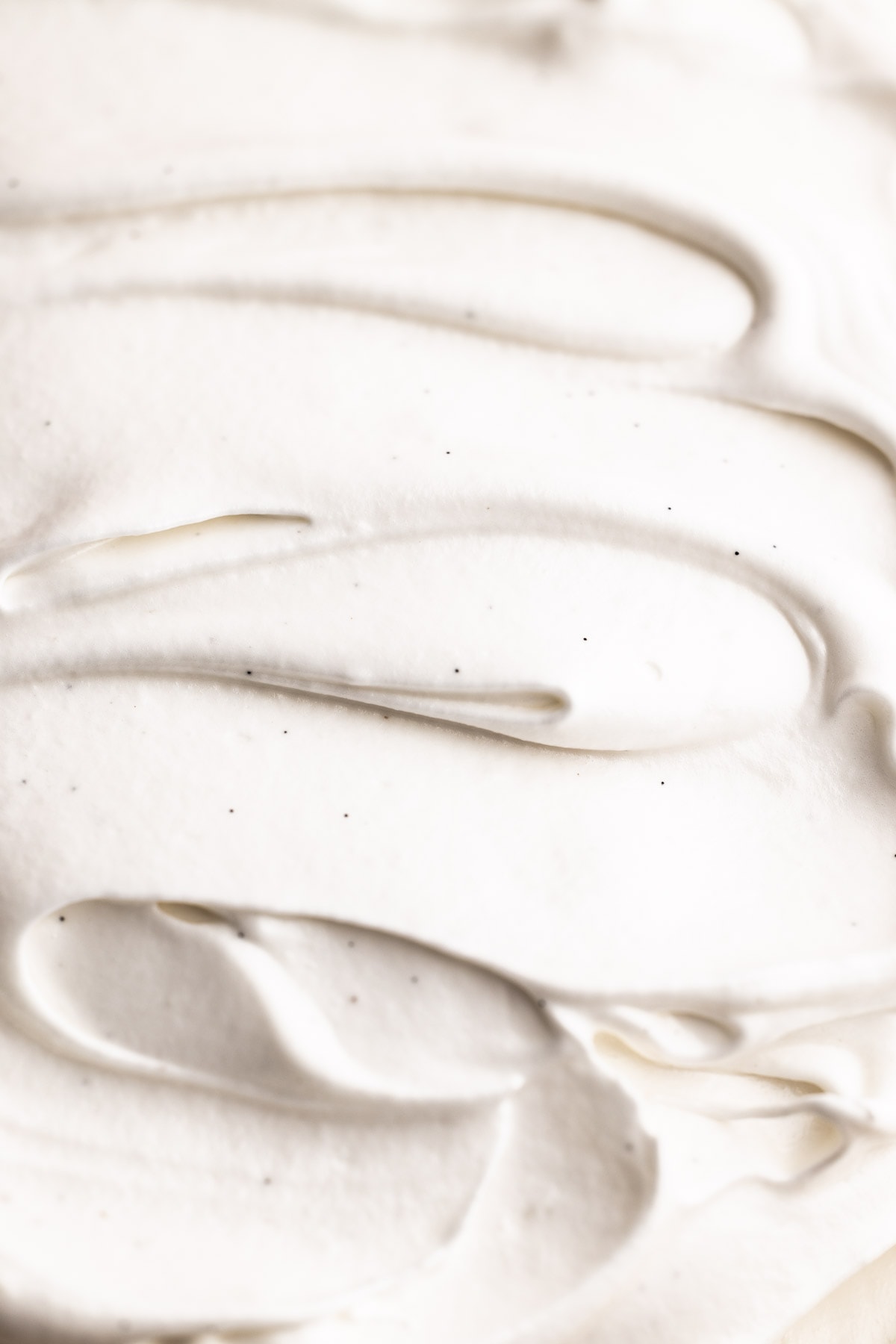
Want to save this recipe?
Enter your email & I'll send it to your inbox. Plus, get weekly updates from me!
Like a satiny sweet cloud, Swiss Meringue is a versatile confection made of cooked egg whites and sugar that is whipped together. It's a bit like a spreadable marshmallow and perfect for pies (like Lemon Meringue Pie or Fluffernutter Pie), used as a frosting for cakes (like this S'mores Cake), or baked into little cookies.
There are several different methods of making a meringue (see below for more details on each one), but in my humble opinion, a Swiss Meringue is the best one. The egg whites are fully cooked, and it has a thick, glossy texture that can't be matched. If you are nervous about consuming raw egg whites (which I always am), use this Swiss meringue in any recipe calling for uncooked meringue.
So, let's get to making it, shall we? The article below is jam packed full of useful information. You can jump around using the menu below, or skip to the end of the article for the full recipe.
Jump to:
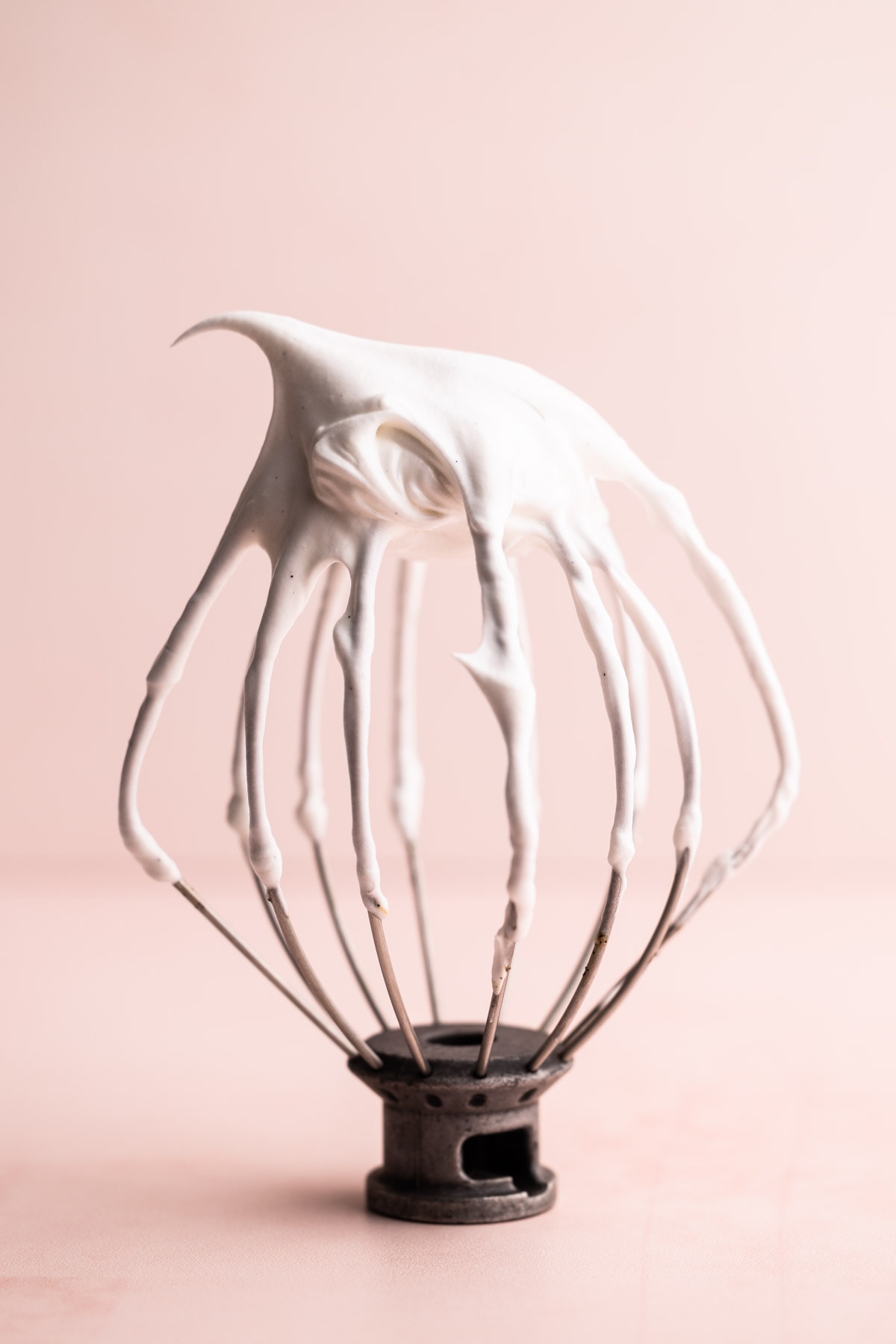
What is a Meringue?
A meringue is a mixture of egg whites and sugar that is beaten until light and fluffy. A meringue has many uses. It can be used to make cookies or a pavlova by baking up the meringue for a long period of time. It can be turned into buttercream by adding chunks of butter to the warm meringue while it is beating. Or, it can be used to top a pie. You can also take the meringue one step further by torching it or placing it under the broiler. This caramelizes the meringue, turning it a beautiful dark color and giving it a toasted flavor.
What Makes a Swiss Meringue Different?
There are three common ways to make a meringue.
The French method is likely the one most people think of. Raw egg whites are whipped up with an electric mixer, and sugar is slowly added until they are light and fluffy. This is the easiest method, but it is also the least stable, and it leaves the egg whites raw.
The Italian method is by far the most unnerving. A sugar syrup is cooked up until it reaches a "soft ball stage" of 235ºF. It is then slowly added to beaten egg whites until it is light and fluffy. This is a very stable mixture, and the egg whites are cooked, but you have to deal with hot sugar.
The Swiss method is somewhere in between the above two. It is made by cooking egg whites and sugar together over a double boiler until the mixture reaches 160ºF (or until they are thickened and all the sugar has dissolved). Next, the mixture is beaten with an electric mixer until light and fluffy. The egg whites are cooked through and safe to consume as is, and they are wonderfully stable with a perfect texture. This is always my preferred way of making a meringue.
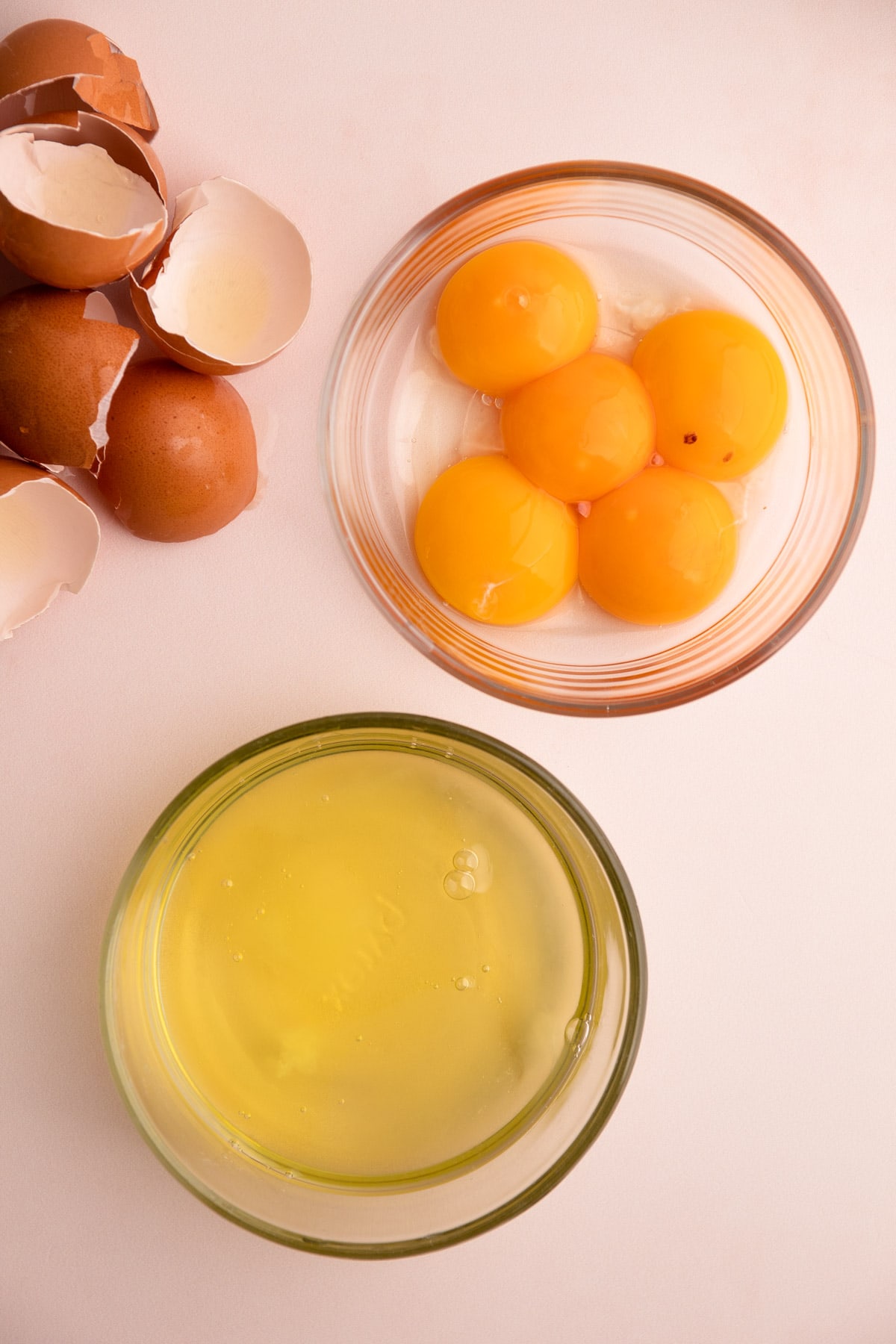
Overview of Ingredients
Here is an overview of the ingredients needed for this recipe. The full recipe is listed below in greater detail.
- egg whites (separate them while they are cold to ensure no egg yolks contaminate the egg whites)
- granulated sugar (try to avoid organic or natural sugar, which typically has larger granules and will take longer to dissolve)
- cream of tartar (see more on this below)
- pinch of salt
- vanilla extract or a scraped vanilla bean
Is Cream of Tartar Essential?
Cream of tartar is a white powder found in the baking aisle in most grocery stores. It is an acidic by-product of winemaking. It is commonly added to all types of meringues to assist in stabilizing the egg whites. If you have it on hand, definitely use it. If you've struggled with meringues in the past, I suggest you get it if you don't have it. If you are making a meringue that you'd like to have last longer (such as on a pie), use it. But is it absolutely essential? Nope. I make perfect meringues all the time without using cream of tartar. It's simply a nice aid to use as an extra bit of security.
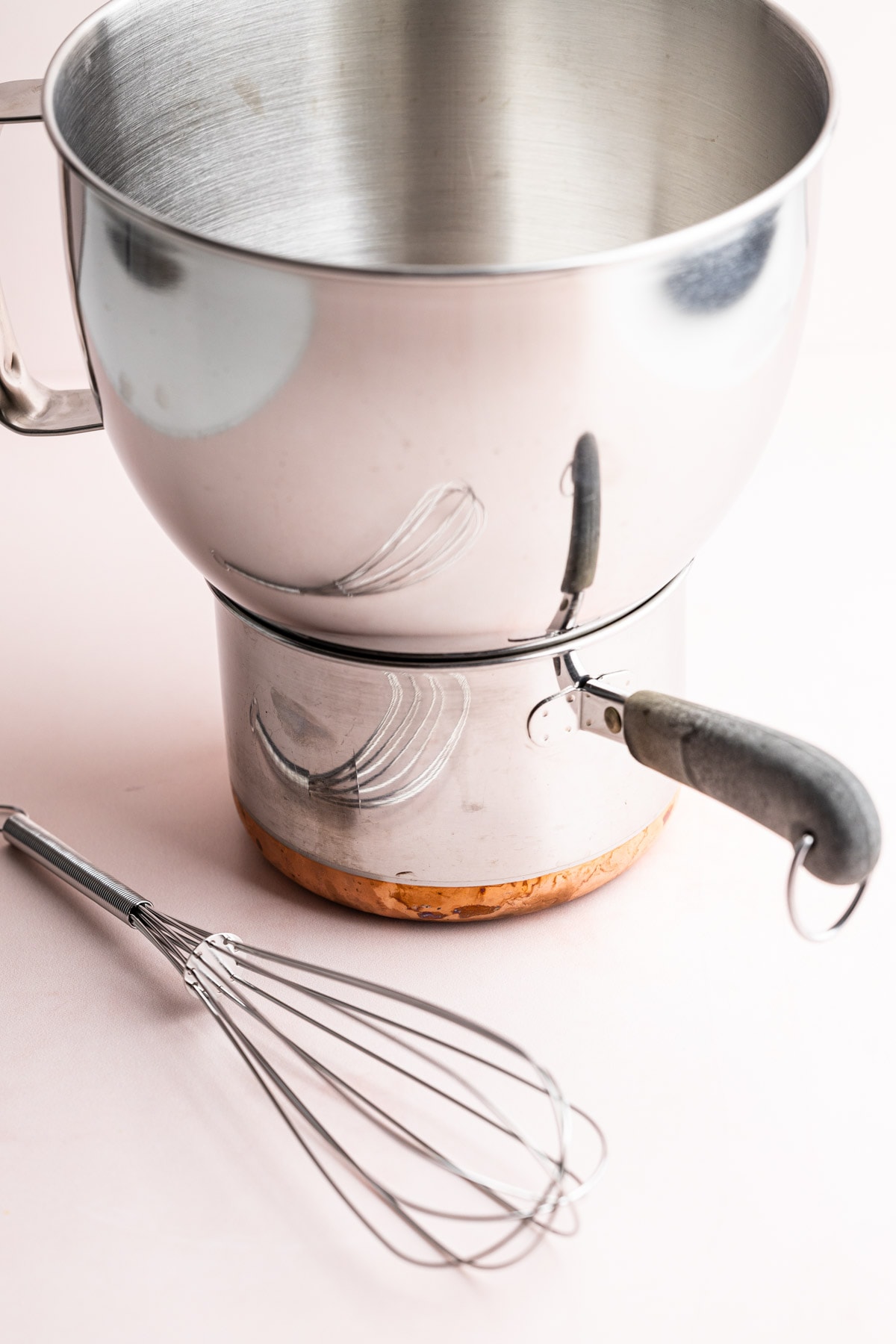
How To Make Swiss Meringue
To cook the egg whites, you will need a double boiler. This involves filling a pot with water at the bottom to create a steam bath that will cook the egg whites in the bowl slowly. For this, I use the bowl for my electric mixer and place it on top of a small pot. A small pot is the best option as it only heats the bottom of the bowl and not the sides, which is useful for preventing any crystallized sugar.
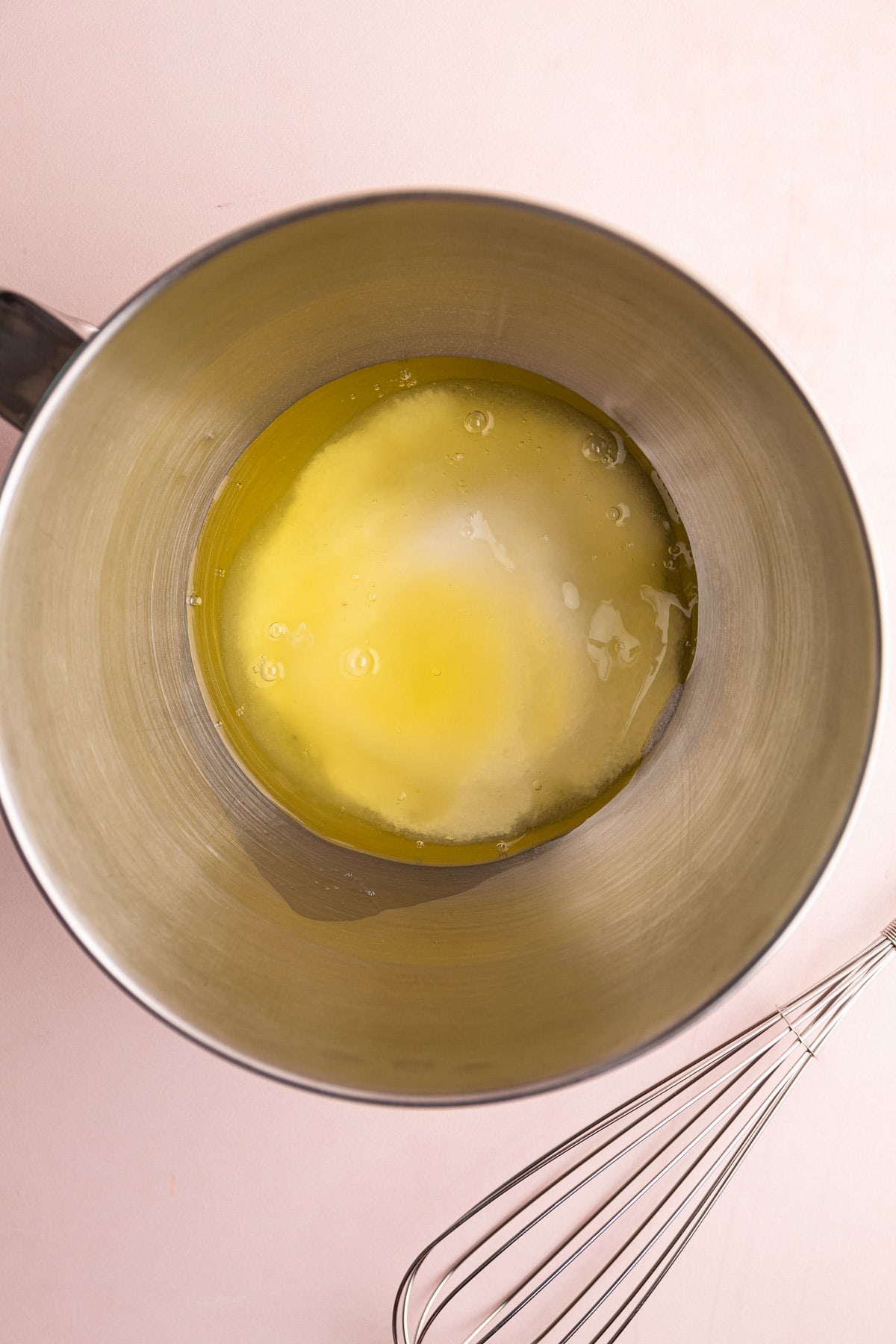
Step 1: Heat the egg whites over a double boiler.
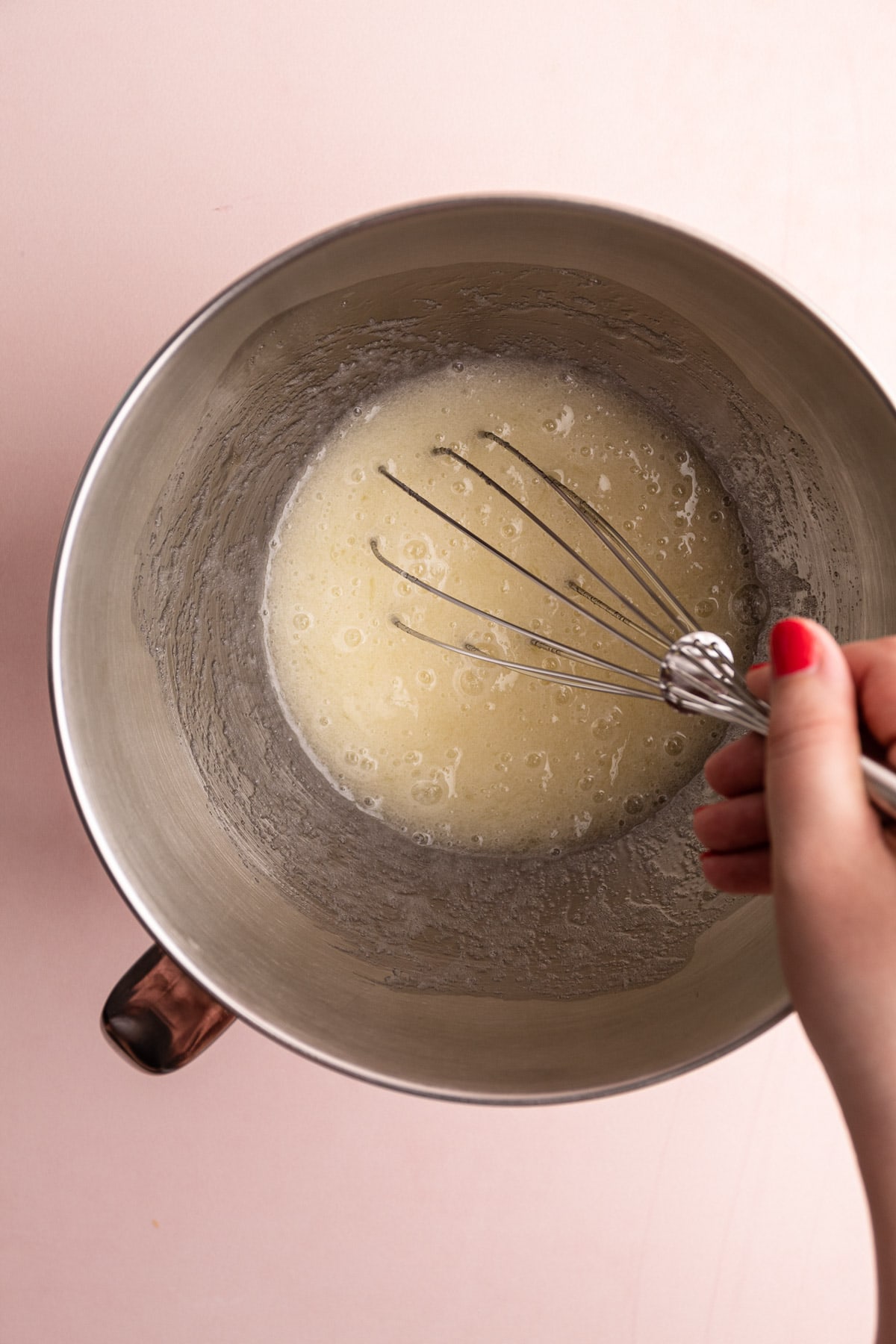
Step 2: Cook the egg whites while whisking constantly until they reach 160ºF.
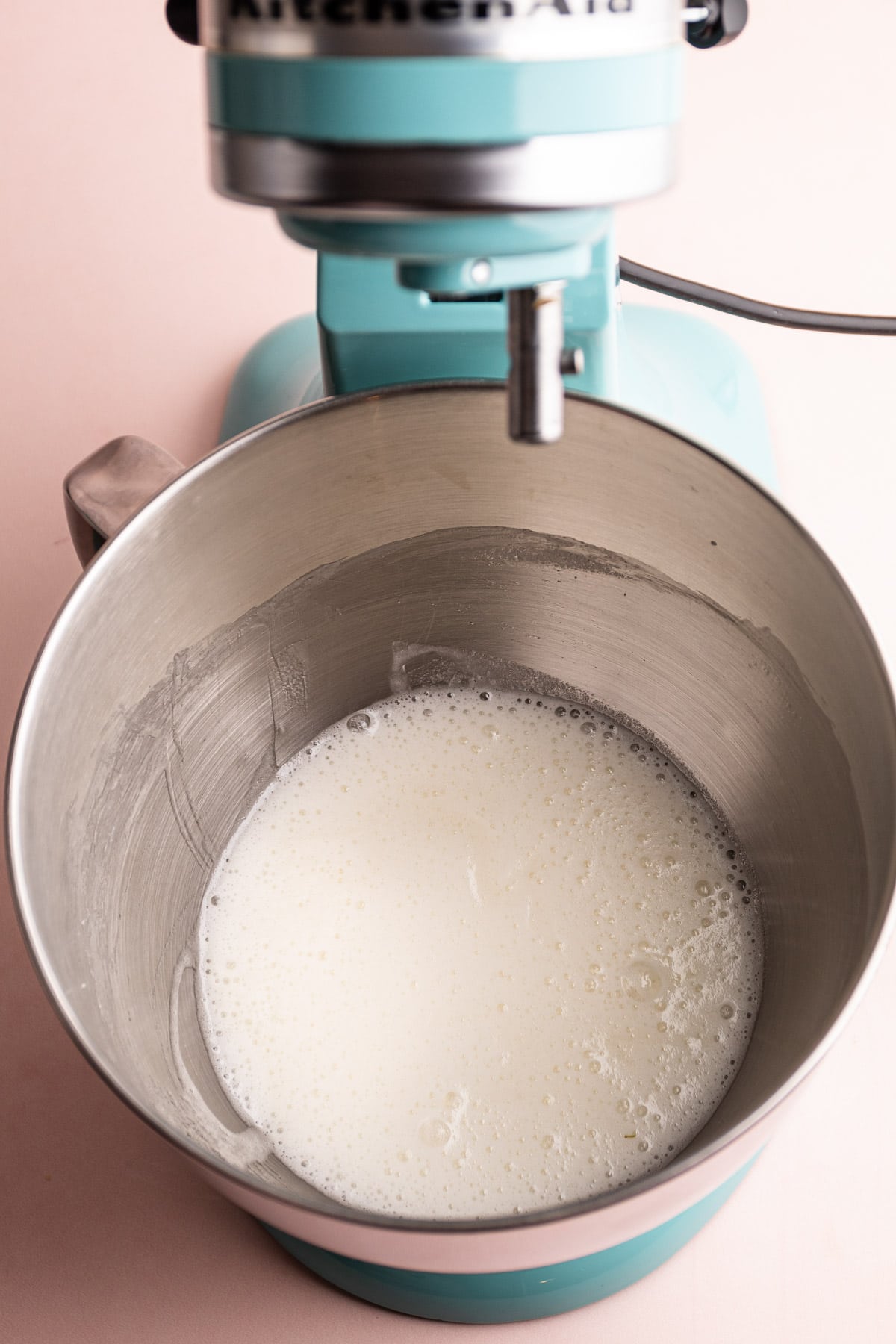
Step 3: Remove the egg whites from the heat and set up with an electric mixer.
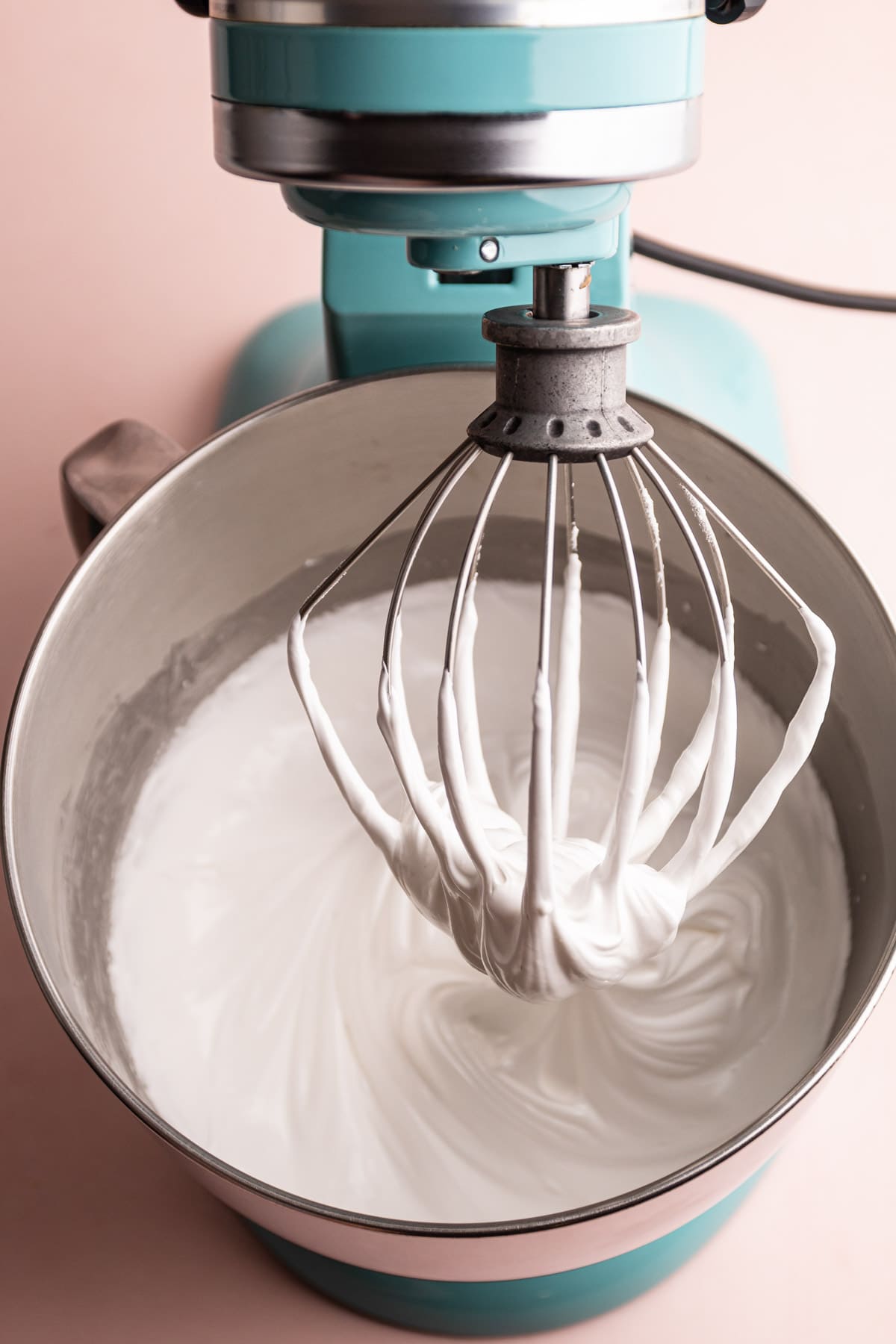
Step 4: Add in the cream of tartar as the egg whites are slowly whipped up, until stiff and glossy.
How to Tell When it's Done
It is possible to under whip and overwhip the meringue.
An under-whipped meringue will be weepy and not hold stiff peaks.
Soft peaks are when you pick up the whisk attachment and the meringue softly falls down, and eventually falls off the whisk in a heap. Medium peaks are when you pick up the whisk and the meringue holds a peak but just barely stays on the whisk without falling. And stiff peaks are when you pick up the whisk attachment and the meringue forms a peak that stays in its place.
A glossy stiff peak is what you are going for here. You'll know you are getting there when the meringue starts to pull away from the sides of the bowl, and as the whisk drags through the meringue, it leaves a very defined wake in its path. You'll also notice the bowl has cooled down significantly and this helps you know the meringue is ready. This whole mixing process takes roughly 8 minutes.
And an overwhipped meringue? This is a little bit harder to do, but an overwhipped meringue will break because all the air bubbles that have been created have started to pop. It will go from stiff peaks to a weepy mess. And unfortunately, there is no saving it. But this is less common, especially if significant sugar is added.
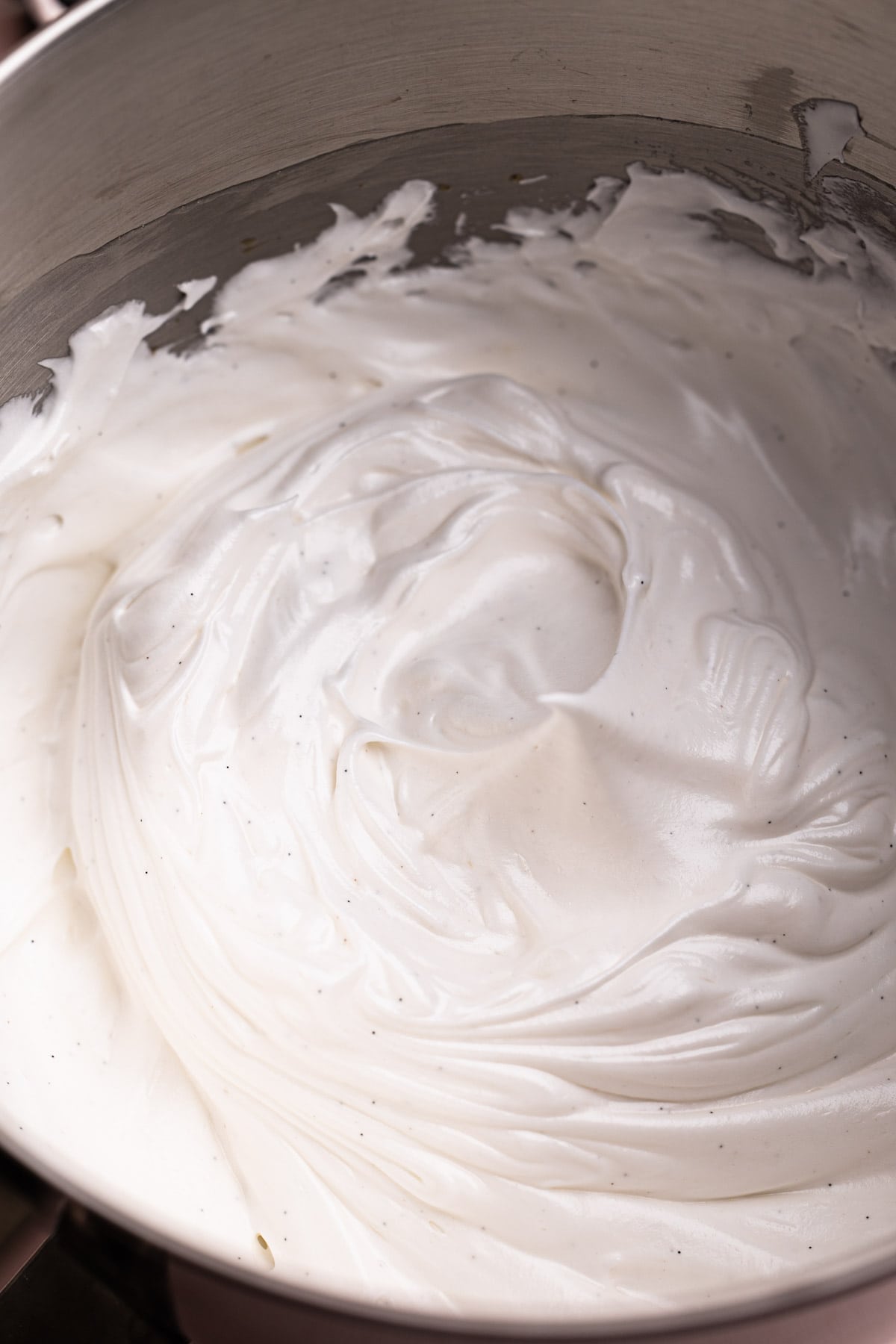
Kelli's Best Tips for Success
- Clean your mixing bowl and whisk attachment well: Whenever making a meringue, I always rewash my bowl and whisk with hot, soapy water by hand. I dry it and then wipe it down with a thin coating of white vinegar. This ensures there are no leftover stops of grease, which could prevent the meringue from whipping up properly.
- Use your hands to separate the egg: I find using my hands to be the easiest way to separate the eggs and to ensure that egg yolks do not get into the egg whites. Egg yolk streaks in the egg whites could prevent them from whipping up.
- Use a smaller pot for the double boiler: You may have noticed in the photo above that I'm using a pretty small pot for my double boiler, and this is very strategic. I like to keep the heat on the bottom because it helps ensure that there are no crystalized sugars on the side of the bowl (see my second tip below for an elaboration on this).
- Make sure all the sugar is melted: Alternate between whisking the mixture and scraping down the sides of the bowl with a spatula when you are heating the egg whites and sugar. You want to whisk the egg whites to ensure they cook evenly and don't scramble. Just be sure none of the sugar has climbed up too high on the side of the bowl before it has a chance to dissolve. This runs the risk of cooking the sugar to the side of the bowl which could result in a grainy meringue. This is why you alternate between whisking and scraping down the side of the bowl to make sure all the sugar dissolves. Whisk and scrape, whisk and scrape.
- Use an instant-read thermometer: The egg whites need to be cooked to a temperature of about 160ºF to ensure they are cooked through and safe to eat. This makes them more stable. An instant-read thermometer reads the temperature quickly and accurately. If you are really stuck and don't have a thermometer, cook the egg whites until the sugar has fully dissolved (you can rub the mixture between your fingers to check) and until the mixture is thickened and starts to get glossy.

Popular Ways to Use Swiss Meringue
Given this is a pie website, I'm going to definitely tell you that a swiss meringue is best used on top of a pie (think: Lemon Meringue or Baked Alaska)! But aside from using it for any type of meringue pie recipe, it also swiss meringue can be used:
- As a cake or cupcake frosting/filling
- As a base for Swiss meringue buttercream
- To make a pavlova
- To make meringue cookies
- On top of ice cream (yes and yes to Strawberry Ice Cream and Best Ever Chocolate Ice Cream)
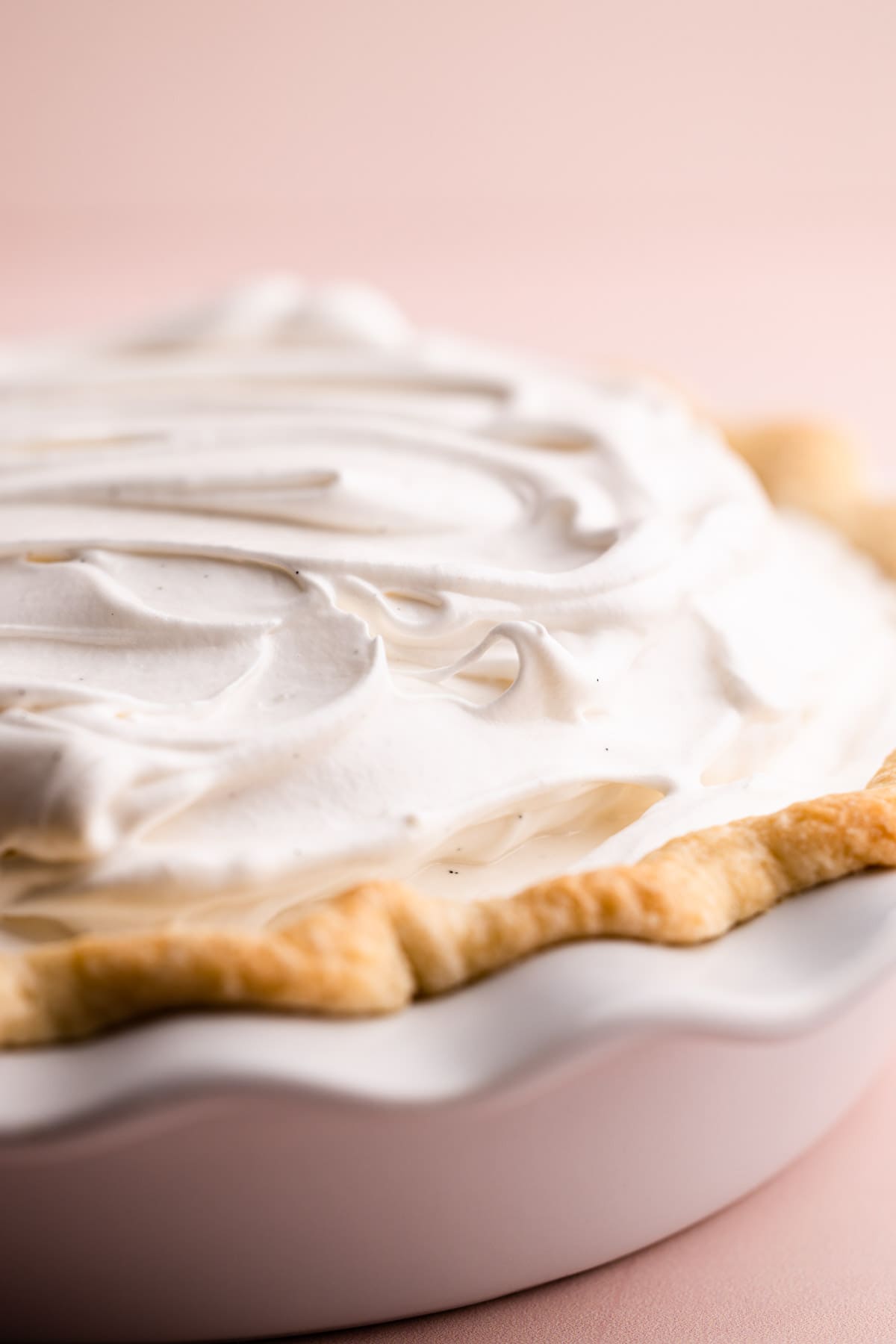
More Baking Tutorials
- Simple Whipped Cream by Hand
- How to Make Homemade Lemon Curd
- How to Make Butterscotch
- How to Bake a Frozen Pie
I am so honored when you make a recipe from my site! If you make this Swiss Meringue Recipe, please leave a star ⭐️⭐️⭐️⭐️⭐️ rating with your experience! If you have any questions about this recipe, feel free to comment here, and tag me on Instagram!
Full Recipe
Swiss Meringue
Fluffy and ethereal, Swiss Meringue is a versatile confection made up of cooked egg whites and sugar that's whipped up. It's a bit like a spreadable marshmallow and perfect for pies, cakes or baked into little cookies.
- Prep Time: 00:08
- Cook Time: 00:10
- Total Time: 18 minutes
- Yield: 2 cups
- Category: Cooking Tutorials
- Method: Mixer
Ingredients
- 3 large egg whites
- Pinch kosher salt
- ¾ cups (150 grams) granulated sugar
- ¼ teaspoon cream of tartar
- 1 vanilla bean, scraped, or 2 teaspoons vanilla extract (optional)
Instructions
- Fill a small, sturdy pot with at least 1 ½ inches of water and turn on the heat to medium-high. This is the bottom of your makeshift double boiler.
- In a heatproof bowl (the metal bowl from your electric mixer is perfect here), combine the egg whites, sugar, salt, and cream of tartar. Whisk together until fully combined.
- Set the bowl over the pot of steaming water. Alternate between whisking the mixture and scraping down the sides of the bowl with a rubber spatula until the egg whites reach a temperature of 160°F and all the sugar has dissolved, roughly between 8 and 10 minutes (see note for troubleshooting).
- Remove the mixture from the heat and attach the bowl to an electric stand mixer fitted with the whisk attachment. Turn the mixer on at the lowest speed, then gradually increase the speed until it reaches medium-high. With the mixer running, add in the vanilla.
- Whip until the meringue is glossy and begins to pull away from the sides of the bowl, about 8 minutes. It should have stiff peaks and should be cooled down significantly.
- Use immediately.
Notes
Alternating between a whisk and a spatula is useful during the cooking stage because it helps ensure all of the sugar melts. Generally speaking the egg whites should be consistently whisked while they're being heated, but occasionally scrape down the sides of the bowl with a spatula to make sure the sugar granules that naturally go up the sides are pushed down to melt. If any sugar granules get stuck to the side of the bowl they could crystalize and create hard granules in your finished meringue.
Meringue is best used immediately. But it can be re-whipped if you need to make it slightly in advance and it has begun to deflate.
Some of the links on this page may be affiliate links. Everyday Pie is a participant in the Amazon Associates Program. As an Amazon Associate I earn from qualifying purchases, at no extra cost to you.


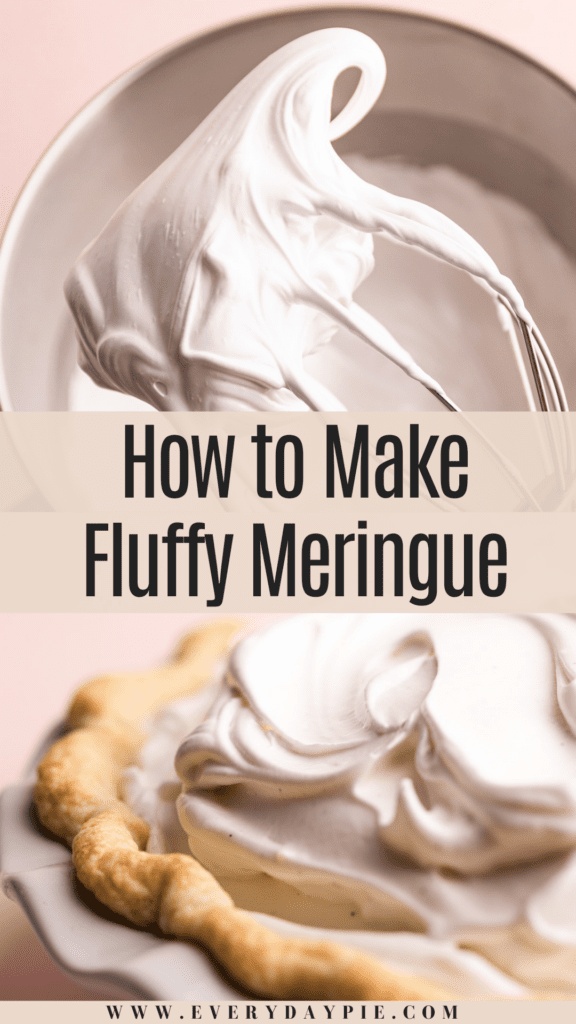
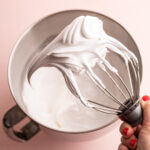
Cindy Dahl
Recipe won't print?
Chelsea
Does Swiss meringue that's been torched freeze well? Was wanting to do that on a pie, but am anticipating leftovers that will need to be frozen... Thank you!
Rhetor Marcus
I used this on a tres leches cake, more authentic than whipped cream but often not suggested. This was surprisingly easy and quick. It will probably become my preferred meringue recipe.
Nyasha
Thank you for posting the meringue tasted lovely but making it was a nightmare for me: It was the meringue version of a blood bath. I had to mix while checking the temp and balancing a bowl over hot water. The thermometer got tangled in the beaters several times but luckily both survived.. But there is meringue everywhere! I will stick with Italian meringue
Sharon
Can I use the glass bowl from my mixer? It won’t hurt the rubber will it?
Kelli Avila
You cannot put the glass bowl on a double boiler. It can break (and mine did!).
Janel
How can you store this? Does it keep well? I just wanted to be able to use it for single servings. Would it last a week that way?
Kelli Avila
It's recommended to use this immediately!
Judy
I wonder if this can then be added to a cooked custard for eggnog so the eggnog is completely safe. New York Times calls their recipe safe, but they whip the whites raw. I think I’ll give this a try.
Kelli Avila
I "think" it should work!
Judy
Hi Kelli, Thank you so much for posting the recipe for that gorgeous looking tart. I've never been a fan of conventional meringue and have been looking for a different kind of topping. I'm glad that I found your Swiss meringue recipe and look forward to making it. Your swiss meringue looks very luscious. Judy
Judy Schwieters
Do you have a recipe for the tart in the picture in the recipe above?
Kelli Avila
Yes! Here it is: https://everydaypie.com/baked-alaska-pie/
Enjoy 🙂